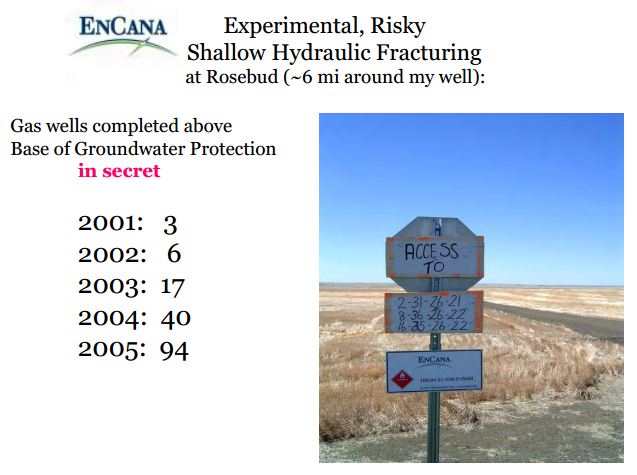38th PARLIAMENT, 1st SESSION Standing Committee on Industry, Natural Resources, Science and Technology Evidence, January 31, 2005
Testmony by Mr. Gerry Protti (Executive Vice-President, Corporate Relations, EnCana Corporation):
We’ve really grown our company. A significant part of it is that we’ve grown it with an unconventional strategy. I’d like, Mr. Chairman, to talk about what that is and distinguish it from conventional supplies. The next slide shows a classic resource pyramid. Any resource has this type of pyramid. It basically says that at the top part of the pyramid you get the easiest supplies out first with the lowest technology. The Canadian natural gas industry is no exception. Since the Second World War conventional supplies have been well developed, and we’re now in a period when conventional supplies are in steep decline, not only in Canada but in the United States as well. There are still additional supplies that can be discovered of conventional gas, but increasingly we’re going to have to go to unconventional supplies or frontier areas to meet North American energy needs. That is the middle band that’s entitled “Tight Gas Sands and NGC”, which is natural gas from coal and gas shales. As you move down this pyramid you need higher prices to pursue these opportunities, but you especially need newer technology. Today, 75% of our assets are in unconventional natural gas supplies, and that’s roughly the amount of production we get from natural gas. So for the largest North American producer, 75% of it is unconventional.
What is unconventional gas? If you think of a traditional oil and natural gas development, you search for reservoirs or pools under the earth’s surface, you find it, and you put a straw in and suck it out. That’s what everyone’s understanding is. In unconventional, there is no reservoir or pool. The gas is distributed throughout western Canada under the earth’s surface in multiple zones of coals, in shales, in sands, and in rock. The key is the technology to unlock the resource.
Mr. Chairman, I’d like to pass around two core samples to give members of the committee a sense of what this looks like. The first one I’ll pass around is from a conventional reservoir where the gas is in the pores between the sands. This is sedimentary rock. This well would produce at 10 million, 20 million, 30 million cubic feet a day–it would just be a gusher–and go into steep decline. This other rock is tight sand. You can tell by its composition, as you go around, that it’s not going to have pools associated with it. The rock is still in the pores here, but you need technology to fracture the rock in a different way to get the gas to produce. This core sample is from southern Alberta, from an historical reservoir that was first discovered in the fifties, and this sample is from an area called Cutbank in northeast B.C. You’ll see a slide that shows how we’ve been able to increase production there. This is completely new technology relative to five years ago, and very exciting in terms of the resource that’s available. … Then there is this big bar of undiscovered resources. This undiscovered bar includes unconventional gas, and if the National Energy Board were here today, they would also indicate that we have no idea how much of the unconventional gas from tight sands or coals we are going to be able to develop, because the technology is so new.
The next slide shows one type of unconventional natural gas–natural gas from coal–and it shows the areas within Canada and the United States that have natural gas from coal. You can see that the extent of the area in Canada is very large. We have effectively very little commercial production of natural gas from coal, but in the U.S. it’s now making up about 8 trillion cubic feet per year. There is tremendous potential in this resource–again, technology development pilots, testing on the ground–to really develop that capability. The next chart is an estimate of the resource available from natural gas from coal. … The next slide…shows our strategy is to develop these unconventional supplies. We call them “resource plays”, and they have the characteristics described in this chart. They are typically a very large resource, not found in pools or conventional reservoirs, but spread in very broad areas. Very long life cycles are required to produce it. There is very little gas per well, but there are lower decline rates and you require a manufacturing type of approach to develop it. We are not focusing our technology development on finding; we know it’s there. In fact, there are large areas within the country, even in Ontario and Quebec, that we think potentially have these supplies. We know it’s there; it’s a question of how to unlock the resource and produce it on an economic basis.
…
EnCana is very excited about this technology. For the purposes of the committee and an industrial strategy, the key is going to be to continue to promote technology development. The fiscal regime should focus on areas where, with our existing resource base, we have the potential to take our technology to the next level–this is technology the world can use at a future date–and obviously to continue with the efforts on smart regulation. We certainly support the work the government has done through the external advisory committee on smart regulation. That allows us the confidence to go forward and be efficient in our capital utilization and develop the technology. [Emphasis added]

Slide from Ernst Presentations
